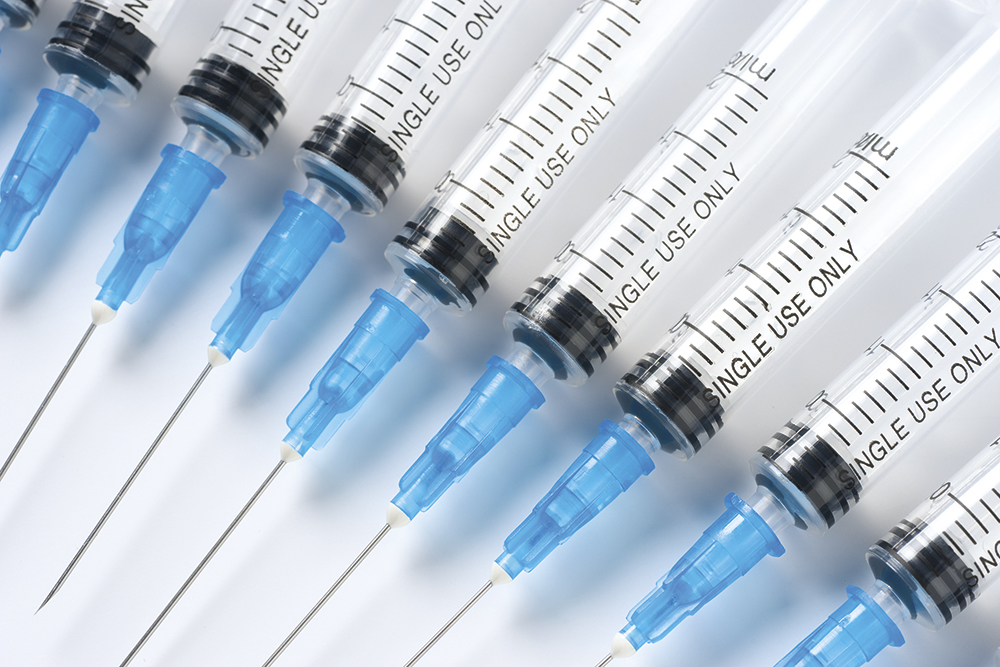To Issue 175
Citation: Gattari J, “Mastering Commercial Manufacturing for Sterile Injectables”. ONdrugDelivery, Issue 175 (Jul 2025), pp 44–47.
Jennifer Gattari delves into what is required to succeed at the commercial phase of sterile injectable manufacturing, going on to explore the challenges that companies can expect and the critical strategies that can help ensure a smooth and scalable journey to market.
The sterile injectable (SI) market is entering an exciting era of growth and opportunity. Valued at approximately US$732 billion (£543 billion) in 2023, it is projected to nearly double, reaching $1.4 trillion, by 2030.1 This surge is being fuelled by key trends, including the rise of glucagon-like peptide 1 (GLP-1) therapies, the continued momentum behind biologics and biosimilars and an increasing demand for patient-centric delivery options, such as prefilled syringes (PFS) and autoinjectors.
As these therapies progress toward commercialisation, the path forwards becomes more intricate. Complexities, such as managing evolving regulatory expectations and maintaining sterility at larger scales, mean that moving an SI from late-stage clinical success to commercial readiness takes more than good intentions — it takes careful strategy backed by deep technical expertise and flexible capabilities.
“AS THE SI SECTOR GROWS, IT BRINGS NEW OPPORTUNITIES TO ADDRESS LONG-STANDING HEALTH CHALLENGES, AS WELL AS NEW EXPECTATIONS FOR MANUFACTURING AGILITY, REGULATORY COMPLIANCE AND PATIENT-CENTRIC INNOVATION.”
AN EXCITING NEW ERA FOR STERILE INJECTABLES
The SI market is entering a dynamic and transformative period, energised by breakthrough advancements across the pharmaceutical and biopharmaceutical industries. Demand for SIs is being fuelled not only by the rise of complex therapies targeting chronic and rare diseases but also by a shift in how medicines are delivered to patients. As the SI sector grows, it brings new opportunities to address long-standing health challenges, as well as new expectations for manufacturing agility, regulatory compliance and patient-centric innovation.
Several key trends are transforming the segment:
- The Expansion of Biologics and Biosimilars: Biologics continue to lead the market’s expansion, offering precision therapies for complex diseases where conventional, small-molecule treatments often fall short. Alongside them, biosimilars are helping to broaden access to life-changing medicines by providing cost-effective alternatives, encouraging greater adoption across healthcare systems worldwide.
- The Rise of GLP-1 Therapies: Originally developed for Type 2 diabetes, GLP-1 analogues are now demonstrating remarkable potential in obesity management. With the global GLP-1 market forecast to grow from $37.4 billion in 2023 to $471.1 billion by 2032, these therapies are poised to become a defining force within the SI landscape, offering new therapeutic options for a growing global health challenge.2
- A Focus on Patient-Centric Delivery: There is a growing emphasis on patient-friendly delivery formats, particularly for therapies requiring frequent or long-term administration. Advances in drug formulation and device technology are enabling more complex therapeutics such as biologics to be delivered through convenient platforms, including PFS, cartridges and autoinjectors, to enhance ease of use and safety for patients managing chronic conditions (Figure 1).

Figure 1: A key trend complicating SI scale up is the variety of patient-centric delivery formats that must now be accounted for, such as PFS and autoinjectors.
CRITICAL MANUFACTURING CHALLENGES ON THE PATH TO COMMERCIAL SUCCESS
While the advances and rising trends in the SI space are creating exciting opportunities for patients and healthcare systems, they are also bringing new challenges to the commercial manufacturing process, which is already inherently complex. The shift from development to commercial-scale SI production presents a distinct set of operational and technical demands, requiring process reliability, as well as rigorous control over sterility, compliance and infrastructure.
Navigating Regulatory Complexity
The regulatory landscape for SIs has always been complex, but it’s become significantly more demanding in recent years. Updates to global standards, such as the revised EU GMP Annex 1, have introduced heightened expectations for contamination control, environmental monitoring and aseptic processing across manufacturing sites.
At the same time, combination products are introducing further hurdles. These therapies fall under dual regulatory oversight, often requiring companies to demonstrate compliance with both pharmaceutical and medical device standards, such as 21 CFR Part 820, ISO 13485 and region-specific guidance for device components. This dual oversight increases the depth and breadth of regulatory obligations, particularly around areas like device validation, human factors engineering and data integrity.
Maintaining Sterility at Commercial Scale
Sterility assurance becomes even more complex as production scales from clinical to commercial volumes. Fill-finish operations must maintain precision across larger batch sizes, requiring rigorous process controls and comprehensive environmental monitoring programmes. Additionally, many of the advanced biologics moving through pipelines today are highly sensitive to temperature, shear forces and oxygen exposure.
These are all factors that can be amplified during commercial-scale manufacturing. Even small deviations during filling, capping or inspection processes can compromise product integrity, resulting in potential batch rejections, costly investigations or loss of supply. Achieving consistent sterility at scale demands not only robust manufacturing practices but also an in-depth understanding of each product’s unique handling and process sensitivities.
Meeting Advanced Equipment and Facility Requirements
Manufacturing the next generation of SI products often requires investments in specialised equipment and facility upgrades. For many complex or highly potent drugs, such as GLP-1 agonists, traditional cleanroom designs are no longer sufficient. Facilities must now incorporate isolator-based technologies, flexible fill lines capable of handling multiple device formats and advanced automation and digitisation solutions to ensure consistent aseptic conditions.
In many cases, adapting existing infrastructure to meet these demands involves significant capital investment and detailed technical planning. Without the right upgrades and flexibility built into production lines, companies may face compatibility issues, longer tech transfer timelines and constraints that limit future scalability.
NAVIGATING COMMERCIAL MANUFACTURING WITH CONFIDENCE
The challenges involved in commercial SI manufacturing are significant, but they are also surmountable. As therapies become more complex and regulatory expectations more demanding, success at scale depends on the ability to anticipate risks, adapt quickly and maintain rigorous control without sacrificing efficiency.
With the right approach in place, pharmaceutical and biopharmaceutical companies can build the resilience needed to navigate this complexity. The following strategies reflect some of the most important considerations for companies looking to scale commercial manufacturing successfully and sustainably in today’s evolving landscape.
Take a Structured, Risk-Based, Approach to Tech Transfer
Commercial success starts with a well-executed tech transfer. For SIs, this process demands far more than simply replicating development-stage processes at commercial scale; it requires a detailed, risk-focused mindset from the outset. A structured, backwards design approach, beginning with the final critical quality attributes (CQAs) needed for patient safety and product efficacy, helps guide the transfer planning.
“EARLY, THOROUGH GAP ANALYSES ARE CRUCIAL TO HELP UNCOVER MISMATCHES BETWEEN SENDING AND RECEIVING SITES, SUCH AS EQUIPMENT DIFFERENCES, FACILITY DESIGN VARIANCES, PROCESS PARAMETER TOLERANCES AND DOCUMENTATION GAPS.”
Every element, from material flow to environmental controls, must be evaluated to ensure that what works at the development scale can be consistently and reproducibly achieved at commercial volumes. Early, thorough gap analyses are crucial to help uncover mismatches between sending and receiving sites, such as equipment differences, facility design variances, process parameter tolerances and documentation gaps. Addressing these proactively can reduce the risk of deviations, delays and unexpected reworks that can disrupt commercial readiness.
Additionally, understanding the product’s sensitivity to environmental stresses, such as temperature, oxygen exposure or agitation during filling, must be incorporated into transfer planning. Identifying and mitigating these potential risks early on not only protects sterility and product quality but also strengthens readiness for regulatory inspections, where tech transfer robustness is often closely scrutinised.
Embed Regulatory Thinking from the Outset
Achieving regulatory compliance in SI manufacturing is not about reacting to expectations after processes are established; it requires proactive integration of regulatory principles at every stage of scale-up and commercialisation. A practical approach starts with embedding regulatory experts into cross-functional project teams early.
Involving experts early ensures that facility designs, aseptic processes and environmental control systems are aligned with current standards from the outset, such as the revised EU GMP Annex 1 and new requirements on the horizon. Regulatory insights should shape the development of contamination control strategies, cleaning validation approaches and equipment qualification protocols, rather than being retrofitted later, when changes are far more costly and disruptive. For combination products, developing a clear regulatory roadmap detailing how quality management systems will address both drug and device requirements can reduce ambiguity and prevent delays during submission and approval.
Another best practice is to design manufacturing and validation documentation with inspection-readiness in mind. This includes building robust audit trails, ensuring data integrity across all critical control points and structuring validation master plans to align with evolving expectations. Validation activities should demonstrate that processes meet predefined specifications, as well as clearly document risk-based rationales for process parameters and environmental controls, reinforcing the quality risk management principles that regulators increasingly expect to see.
Build Flexibility into Sterility Assurance at Scale
Maintaining sterility becomes considerably more complex as batch sizes increase and production moves toward commercial volumes. Scaling up SI manufacturing amplifies operational risks, from the impact of faster line speeds on fill precision to the greater difficulty of consistently maintaining environmental controls across larger production windows.
To mitigate these risks, manufacturing processes must be designed with scalability and flexibility in mind. Stress-testing fill-finish parameters at commercial-representative scales is critical. This includes validation of key variables, such as fill volume consistency, container closure integrity and line speeds. Products that are sensitive to temperature, light, oxygen exposure or shear forces require additional process controls and real-time monitoring to safeguard CQAs.
“ADAPTING OR DESIGNING FACILITIES TO SUPPORT THIS COMPLEXITY MEANS MAKING DELIBERATE INVESTMENTS IN FIT FOR-PURPOSE TECHNOLOGIES.”
Invest In the Right Infrastructure, Not Just the Biggest
Achieving commercial readiness for SIs often hinges on facility and equipment capability. As product pipelines increasingly include high-potency biologics, lyophilised drugs and patient-centric formats such as PFS and cartridges, manufacturing environments must evolve beyond the limits of traditional cleanroom spaces.
Adapting or designing facilities to support this complexity means making deliberate investments in fit-for-purpose technologies. Isolator-based filling lines can significantly reduce contamination risk compared with traditional open systems, supporting enhanced sterility assurance in line with evolving regulatory expectations. Flexible fill lines capable of handling multiple container types and volumes enable manufacturers to accommodate both liquid and lyophilised presentations without extensive revalidation, improving operational agility.
The goal is not simply to scale, it is to scale intelligently. Facilities and equipment that are purpose-built to align with the specific requirements of the product portfolio are far more likely to support successful, sustainable commercial supply. Investing early in the right infrastructure protects product quality, accelerates launch timelines and reduces the risk of costly retrofits or remediation down the line.
BUILDING SUSTAINABLE SUCCESS IN SI MANUFACTURING
As SI therapies continue to evolve, the path to commercial success will only become more complex. Manufacturers that prioritise risk-based planning, embed regulatory alignment early, build resilient supply models and invest in the right infrastructure will be best positioned to meet future demands with confidence. Working with a CMO that applies these strategies, along with proven experience in SI scale-up, regulatory compliance and flexible manufacturing, can make the difference between a challenging launch and a seamless, sustainable commercial supply. In an environment where precision, agility and reliability are vital, partnering with the right CMO can help companies navigate complexity and deliver breakthrough therapies to the patients who need them most.
REFERENCES
- “Sterile Injectable Drugs Strategic Market Research Report 2024: Global Market to Reach $1.4 Trillion by 2030 – Biosimilars Gain Traction, Opening New Opportunities”. Press Release, Research And Markets, Nov 2024.
- “GLP-1 Analogues Market by Product, Format, ROA, Indication – Global Forecast to 2032.” Market Report, Markets and Markets, Jul 2024.

